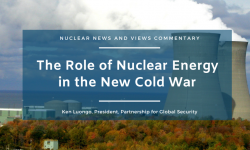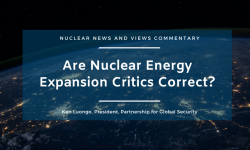The U.S. has woken up to the fact that Russia is aggressively advancing on the nuclear export playing field, that China is not far behind, and that this will impact American international influence and objectives for decades to come. Nuclear export is more than an economic issue. In this century it is about the formation of the geopolitical and geostrategic landscape and the preservation of strong nuclear non-proliferation and security standards.
Last month one of the State Department’s big thinkers on nuclear issues outlined a new approach to nuclear exports that included the use of “non-binding bilateral political arrangements more akin to a memorandum of understanding (MOU) than a full 123 [agreement].” The goal is to connect with countries that are considering nuclear power and help them build the hard and soft infrastructure that is required to effectively operate the technology. If the country decided to move forward and desired U.S. technology, a formal 123 nuclear cooperation agreement could be negotiated and sent to the Congress for approval.
Undergirding this evolution in approach is a rejection of the “business as usual” model that allows authoritarian rivals of the U.S. to undercut the important non-proliferation and security limits that it incorporates into its nuclear cooperation agreements. If the U.S. cannot reach a 123 agreement with a country America’s strong requirements can be circumvented.
This change in policy will attract attacks because it may look like a backtracking on the 123 process. But it is a reflection of reality. The international nuclear game has significantly changed, and the U.S. is playing catch-up. Russia has over 40 nuclear export MOU’s in place around the world, and it controls half of all reactor construction and fuel supply agreements. China has a three-pronged strategy for civil nuclear domination that includes building reactors in the U.K., one of America’s strongest allies.
The interplay between nuclear export and non-proliferation is highly charged, and it has been a source of intense conflict even with strong U.S. allies like Japan and South Korea.
Recently the focus has been on the competition to supply Saudi Arabia with two nuclear reactors. The U.S. is a contender along with Russia and China. But the Saudis are not making it easy to make a deal. There is pressure to apply the Gold Standard to any U.S.-Saudi deal, which would ban the provision of uranium enrichment and spent-fuel reprocessing technology. If the Saudis pick a nuclear partner that is an American geopolitical rival, that will leave the U.S. on the sidelines, along with the strong non-proliferation and security standards it has long championed.
It is not clear if the consequences of failure in this challenging balancing act are well understood among nuclear policymakers and influencers. Certainly a tantalizing catnip cocktail of factors has led to questionable speculation that the administration is trying to circumvent the Congress and provide Saudi Arabia with the tools to manufacture nuclear weapons.
The reality is that nuclear export in the 21st Century is about more than energy technology transfer. With Russia and China gobbling up the current global nuclear market and making plans to dominate next-generation reactor technologies, the U.S. and its allies must adapt quickly and compete much more aggressively and nimbly. The alternative is to cede the future control of civil nuclear power to two countries that do not like to play by the rules.





